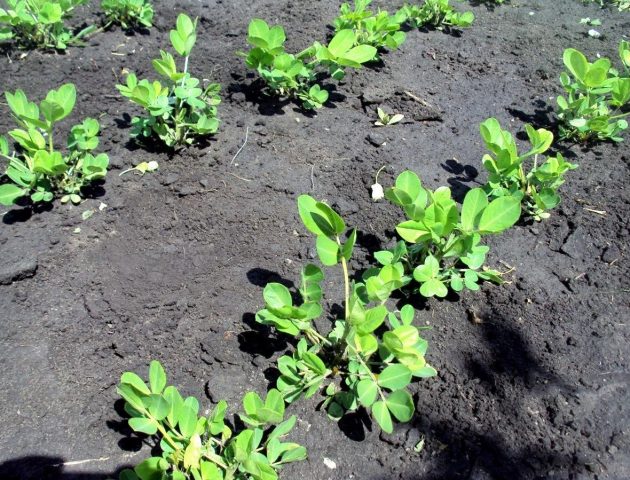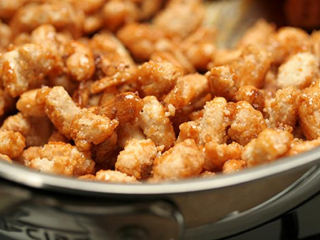Content
Peanut is an annual legume plant native to South America. It is cultivated in the USA, China, India and other countries around the globe. You can grow peanuts in the Russian climate. When growing, it is important to follow planting technology and provide good care.
Peanut growing technology
Peanut is a plant 25 - 70 cm high. The root is branched, penetrates to a depth of 1.5 m. The root system occupies up to 1.5 m in girth. Therefore, the plant is resistant to drought. In nature, it prefers a humid and warm climate.
Peanuts produce yellow-orange flowers. The flowering period lasts only 12 hours. After pollination, the ovary descends to the ground. About 2000 flowers appear on one plant. The number of fruits ranges from 30 to 80. Peanuts ripen in the ground, which is why they are called groundnuts. Is the growing season between 120 and 160 days? depending on the variety.
Features of agricultural technology for growing peanuts:
- sunny place, no shady areas;
- the best temperature range is from +20 to +27 °C;
- constant circulation of air masses;
- chernozem or neutral soil;
- increased content of magnesium, calcium and humus in the soil;
- low soil salinity;
- temperature regime for seeds and seedlings;
- high soil moisture when flowers and ovaries appear;
- no stagnation of water in the soil;
- hilling of plants.
How to plant peanuts in the garden
To grow peanuts in the country, it is important to prepare the area and seeds for planting. It is grown in open ground only in the southern regions. Be sure to comply with work deadlines.
Landing dates
Groundnut seeds germinate only in warm soil. Minimum temperature from +12 to +15 °C. The best mode is from +25 to +30 °C. Spring frosts are detrimental to the plant. Therefore, it is important to choose a period when the soil is well warmed up and the cold weather has passed.
Peanut planting begins in May or early June. In the forest-steppe zone, work is postponed to the second ten days of May. When choosing dates, they are guided by the weather forecast. If frosts are expected, it is better to postpone planting. If the seeds have already been planted and cold weather is expected, then cover the beds with agrofibre or film at night.
Selection and preparation of a landing site
Before you start growing peanuts, it is important to properly prepare the area. The plant grows well even in poor soils. When growing a crop, the soil is saturated with nitrogen. Therefore, peanuts are used to enrich depleted soil.
The best option is soil rich in humus and minerals. River sand and fertilizers are added to clay soil.If the soil is sandy, then its composition is improved with clay and compost. Peanuts do not tolerate saline or acidic soil. In such cases, liming is carried out.
Maintaining crop rotation will help avoid diseases. Growing peanuts after beans, beans, peas and other legumes is not recommended. If you break this rule, there is a high risk of root rot.
Site preparation begins in the fall. The soil is dug up and fertilized with humus. For 1 sq. m is enough 1 - 3 kg. In spring, the beds are loosened with a pitchfork. In dry form, add 40 g of Nitrophoska per 1 sq. m.
Preparing peanut seeds for planting
Before planting, the seeds are processed. This will improve their germination and destroy pathogenic bacteria. It is better to purchase planting material at gardening stores. The varieties Adyg, Bayan, Klinsky, Valencia, Stepnyak are suitable for the middle zone.
Only raw beans are used for cultivation. If the nuts have been subjected to heat treatment, they will not be able to sprout. The seeds are assessed visually: they should still have a red skin. It is recommended to purchase peanuts in shell and carefully remove them before growing. Also, there should be no traces of mold, rot, or cracks on the surface. Large nuts produce the best seedlings.
The procedure for preparing peanuts for cultivation:
- In order for peanuts to sprout, they are soaked for 5 hours in warm water. It is recommended to add a growth stimulator. Treatment in a solution of potassium permanganate will help to avoid the occurrence of diseases.
- The liquid is drained.
- A damp cotton cloth is placed in a large basin.
- Peanuts are placed on top.
- The seeds are covered with another piece of damp cloth.
- After a day, the halves of the nuts open and sprouts appear.
If the seeds do not sprout 3 days after treatment, then they are not used for planting. If the beans have sprouted, they can be immediately planted in the ground.
How to plant peanuts in open ground
Groundnuts are planted in furrows 10 cm deep. If you plan to grow several rows, then make a gap of 40 cm. Seeds can be planted according to a 60x60 cm pattern.
Procedure for planting peanuts:
- The furrows are watered with warm water.
- The beans are placed in furrows. Leave at least 30 cm between plants.
- The seeds are sprinkled with a layer of soil 8 cm thick.
- Shoots will appear in 14 - 20 days.
Seeds should be protected from birds. To do this, use a net or scarecrow. Until the shoots appear, the peanuts are covered with a non-woven cloth.
How to grow peanuts in the garden
Proper planting and cultivation of peanuts will ensure a high yield. Caring for plants includes weeding the beds, adding moisture and fertilizers, and hilling the bushes.
Weeding and loosening
The peanut bed is regularly weeded. Otherwise weeds will grow and choke out the plantings. Loosening of the soil is also carried out. This stage is especially important during the flowering period. The ovaries form in the ground. If the soil is too dense, the flowers will not be able to penetrate deeper and will die. It is convenient to combine loosening with weeding.
Watering and fertilizing
Peanuts prefer moist soil. To ensure better water absorption, the soil is loosened after watering. Do not allow the soil to dry out or form a crust on the beds. For irrigation use warm, settled water.
When flowering, peanuts are watered 1-2 times a week. It is best to choose morning or evening hours when there is no direct sun exposure. Additionally, the plants are sprayed.When choosing an irrigation scheme, precipitation in the region is taken into account. During drought, plantings are watered by sprinkling. Water is poured onto the roots and leaves and applied into the furrows between the rows.
During the season, it is enough to feed the peanuts 2-3 times. The first treatment is carried out when the seedlings reach 10 cm in height. For treatment, prepare a solution containing 20 g of ammonium nitrate, 50 g of potassium sulfate and 60 g of superphosphate per 10 liters of water. In mid-year, only potassium and phosphorus fertilizers are applied.
Hilling
Hilling is a mandatory step in caring for peanuts. It is carried out when the ovaries begin to descend to the ground. The roots of the plant are covered with loose and moist soil. An alternative option is to pour a substrate of humus, sand or sawdust on top.
Peculiarities of growing groundnuts in different regions
Growing peanuts in central Russia or Siberia has its own nuances. In general, agricultural technology is the same for all regions. When planting and caring, take into account the local climate.
Growing peanuts in the Moscow region
To grow peanuts in the Moscow region in open ground, planting dates are selected correctly. They wait until the middle or end of May, when the spring frosts have passed. Sand and compost are first added to the soil. After planting, the beds are covered with film. Otherwise, the peanuts are provided with standard care: watering, fertilizing, hilling.
Growing peanuts in Siberia
To successfully grow peanuts in Siberia, it is important to prepare the beds. The soil is dug up or fertilized. If return frosts often occur in the region, then the seeds are planted in a greenhouse or greenhouse. It is most convenient to place the bushes in a checkerboard pattern.
If weather conditions do not allow you to grow groundnuts in the garden beds, then it is better to plant peanuts at home. Large plastic containers are chosen for it, where drainage holes are made. Plants are kept on the south side. The soil is regularly moistened.
Diseases and pests
During the growing process, groundnuts can be seriously damaged by fungal diseases. They usually develop in rainy weather. To save the plantings, it is important to detect warning signs in time.
The following diseases are most dangerous for peanuts:
- Powdery mildew. The lesion has the appearance of a whitish coating that appears on the leaves. Gradually, the spots grow, and the foliage turns yellow and dries. Powdery mildew also affects the stems and ovaries.
- spotting. The disease is diagnosed by white, brown spots on peanut leaves. Gradually, the tissue inside the lesion dies and holes form.
- Black spot. Develops at high humidity. Black spots up to 15 mm in size form along the edges of the leaves. As a result, the foliage dies.
- Fusarium wilt. The disease leads to yellowing of the shoots, while the root system rots. The plant dies before harvest.
To avoid diseases, agricultural practices are followed when growing groundnuts. It is important to treat the seeds before planting, observe crop rotation, and regulate watering. When signs of disease appear, the bushes are sprayed with a solution of Quadris, Skor or Topaz.
Peanuts attract aphids, caterpillars, thrips and other pests. A mixture of tobacco dust and wood ash is used against them. The most dangerous for the plant is the wireworm, which gnaws through the shells of fruits and eats nuts. To combat wireworms, traps are set with bait in the form of carrots and potatoes.
Harvesting
Groundnuts are harvested before the onset of cold weather. When nuts are frozen, they lose their taste and become unsuitable for consumption. When the leaves of the plant begin to turn yellow, dig up several fruits. If the seeds are easy to clean, then begin harvesting.
Typically, the harvest is harvested when the temperature reaches +10 °C. A dry day is chosen for work. Plants are dug up using a fork or other garden tool.
The beans are collected in bunches and hung with their roots down. Groundnuts are kept in a dry, ventilated area. Such nuts ripen well and contain a maximum of useful substances.
After 2 weeks, the fruits are picked off and washed with running water. The peanuts are then dried in a warm place. As a result, the shell becomes brittle and the nuts acquire flavor. The harvested crop is kept in a dry and warm room. Beans should be protected from direct sunlight and high humidity.
Advice from experienced gardeners
Conclusion
Even a novice gardener can grow peanuts. The plant is provided with certain conditions: fertile soil, processing of planting material, care of seedlings. Growing peanuts in different regions has its own characteristics. To get a good harvest, they follow technology and take into account the experience of other gardeners.















